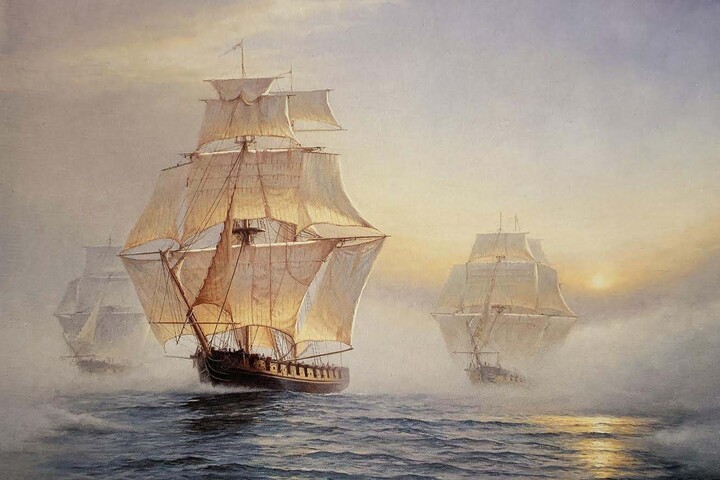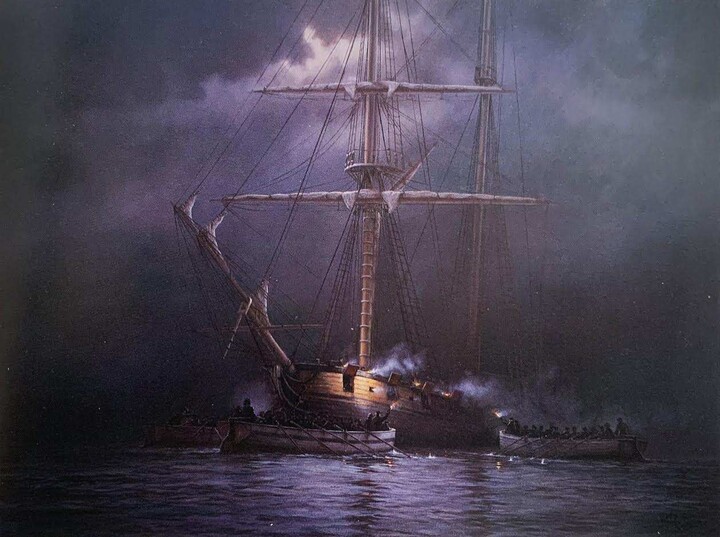
The "Most Remarkable Military Action of the War of 1812"
By Olivia E. Jackson
In the early 19th century, the Napoleonic Wars raged through Europe. Great Britain and France were fighting for leadership, power, and dominance. Britain implemented a naval blockade in the hopes that it would prevent and deplete France’s resources; the French retaliated by enacting trade embargoes against the British, attempting to disrupt their relationships with continental allies.
The impact of Britain’s naval blockade also extended to American merchant ships: they were prevented from trading with European countries other than Britain. Additionally, the British captured Americans from their merchant vessels, and forced them to serve in the Royal Navy. Because of this, frustration, discontent, and acrimony grew and radiated throughout the United States, leading the country to declare War with Great Britain on June 18, 1812.
At this time, Nantucket was still repairing ships and rebuilding the town from the detriment suffered during the Revolutionary War. During the War for Independence, the British destroyed Nantucket’s whaling fleet, which was a major source of economic prosperity for the island. Nantucketers nearly starved as resources were depleted, and resentment of European trade preventatives still lingered. Despite attempts to voice their disapproval of engaging in war, islanders would be affected by yet another British-American conflict and Nantucket would soon be the sight of a bloody battle.
Captain Jules Ordronaux was a notable mariner. Around 1813, after seeking funding from a Frenchman, Captain Ordronaux purchased a remarkable American vessel in New York, which was part schooner and part brigantine. He sailed her to France where she was customized for privateering and christened the Prince de Neufchatel. In a matter of months, Captain Ordronaux and his crew had successfully pillaged three million in cargo from 14 British merchant ships. The Prince de Neufchatel had become notorious, pernicious, and uncatchable.
In the Egan Art Collection, a model of the Prince de Neufchatel by Nikita Carpenko on display at the Nantucket High School Library.
Allegedly, after a nine month pirating tirade and creating chaos for Britain’s commercial shipping and trading endeavors, the Prince, with an American flag proudly billowing from the mast, was returning to Boston with her latest commandeered ship, Douglas. The captured ship was stocked with rum, sugar and coffee. During the voyage, Captain Ordronaux anchored off Nantucket, hoping to acquire aid from an island mariner who could guide him and his crew around the island’s shifting shoals. In her exposed position off Nantucket's south shore, the British man-of-war ship Endymion spotted the infamous Privateer.

Prince de Neufchatel off Surfside, 1814 by Rodney J.K. Charman
The British ship had more guns and more men than the Prince. Despite her exceptional speed and the pugnacious spirit of Captain Ordronaux, the Privateer, in her perilous position, was doomed. Fortuitously, the island’s quintessential fog descended on the two ships, engulfing them in a grey sheet of obscurity, preventing the Endymion
from firing her deadly canons.
With the British attack momentarily postponed, the crew of the Prince assembled and loaded the roughly 200 muskets on board, made the sides of the ship slippery to prevent an easy British ascent, and stocked the canons with musket balls. As the veil of fog began to dissipate, five longboats with over 100 crew members from the Endymion rowed toward the Prince, attacking the Privateer from both sides.

Prince de Neufchatel Off Tom Nevers - 1814 by Rodney J.K. Charman
Supposedly, the battle only lasted twenty minutes. It was full of bloodshed, intense violence, and death. Despite the great discrepancy in numbers of men, the British surrendered after they lost 49 people. 37 of their men were wounded, and 30 were taken as prisoners. The Americans suffered seven deaths, and 15 were severely wounded. Shortly after, the injured men from both crews were taken to Nantucket for medical treatment.
Captain Ordronaux seized the opportunity of victory to flee from Nantucket, bringing the Privateer to the safe harbor of Boston. Allegedly, the Endymion returned to her base at Tarpaulin Cove off Martha’s Vineyard. Douglas, the captured ship previously accompanying the Prince, is said to have run aground near Sesachacha. Her cargo of 421 molasses hogsheads, 412 bags of coffee, three bags of ginger, 254 bales of cotton, and 28 mahogany logs were left for islanders to plunder and consume.
Following his voyage to Boston, Captain Ordronaux retired as a wealthy, notable sea captain. The Prince de Neufchatel returned to sea in December of 1814 under the command of a new captain. Five days later, she was captured by the British.
The infamous Privateer brought Nantucket and its residents into the War of 1812. She was revered for her revolutionary design and unparalleled speed. The Prince de Neufchatel became the model for the most magnificent sailing vessels in the world, the clipper ships of America. Her legacy in Nantucket waters and her role in the War of 1812 have sailed through history for more than 200 years.
Photo courtesy of George Riethof, Nantucket Aerial photographer
Tall Ship "Lynx," a Replica Privateer
Egan Maritime Institute has partnered with Tall Ship Lynx for more than six years. The iconic Privateer can be seen in Nantucket harbor from early June to mid September every summer. Lynx has served as an educational vessel for Egan's Sea of Opportunities' students as well as an entertainment venue for special summer programming. Lynx is a replica of an actual privateer built by Thomas Kemp in 1812 in Fell’s Point, Maryland. The original Lynx was among the first ships to defend American freedom; she evaded the British naval fleet, which was blockading American ports at the time, and served in the important privateering efforts. At the outbreak of the War of 1812, the American Navy consisted of only 17 ships – eight frigates, two brigs, and seven assorted smaller vessels.